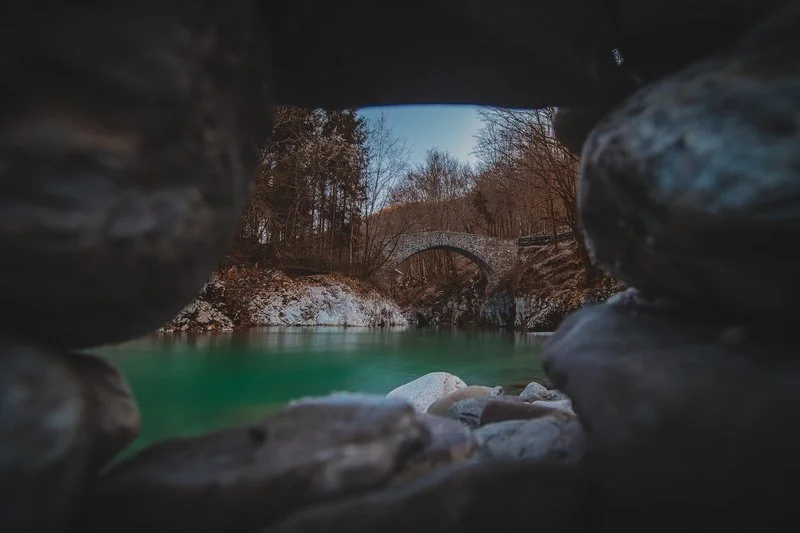The Valley of Giants
The Valley of the Giants is a realm like no other. It is a place where humans, giants and mythological beings mingle, and where tales abound of buried cities and lost treasures. Be careful, however! Wickedness may lie around the next corner.
The Valley of Giants draws inspiration from the real-life Nadiža Valley, and the river of the same name. The Nadiža River is the offspring of Beli Potok (White Stream) and Črni Potok (Black Stream) which merge in Breginjski Kot (Breginj’s Corner) in northwestern Slovenia. The word Nadiža is Slovene in origin meaning “water that simmers (bubbles) with a strong source during the day”.¹ ² It is the warmest of Alpine rivers in the region, perhaps in all of Europe, and is said to have healing properties, which may be why the Nadiža Valley has been inhabited since prehistoric times. It is a landscape that is heavily steeped in myth, legends and tales about giants and mythological beings, buried towns and lost treasures, and how locals outwitted enemies such as Atilla the Hun and the Ottoman Turks.
According to folk tradition, giants once inhabited this valley, living primarily underground in caves.³ When they did venture outside, they were often found at the Giant Stone Table and Chairs – three megaliths each approximately 5 metres in size and resting on their tips – where they ate and soaked their feet in the warm waters of Nadiža. It is said that under the altar in the church of St. Volar, there is an entrance to a cave where the giants kept their treasure.⁴
Another folk tale speaks of the buried town of Molida.⁵ Its townspeople were gluttonous and greedy, and so they were punished by God, with an avalanche from Mount Matajur burying the townspeople and their treasure along with them.
Krivopete are female supernatural beings, whose name derives from their most prominent physical attribute, backward feet (krivo: ‘twisted’, pete: ‘heels’)⁶. They were said to inhabit certain caves, caverns, and the like. They were “ambivalent” in character, either helping or punishing humans depending on how they were treated. When they did offer advice to humans, it was often in rhyme. One particular tale mentions the Krivopeta, who had a particularly large hidden treasure, who resided in Kocova Cave near Napoleon’s Bridge, over the Nadiža River⁷.
In the fifth century, Attila the Hun is said to have marched through this valley, razing all villages to the ground.⁸ The locals, however, led by Queen Vida had already retreated to safety of Landar Cave. Attila and his soldiers sieged this cave for months, hoping to starve the Queen and her people into submission. After many months, they were down to their last bag of wheat. Queen Vida hurled its contents down in front of Attila and his soldiers and cried out: “As many grains of wheat you see before you, so many sacks of wheat we still have in the cave, procured through a secret entrance!” This bluff was successful, with the siege coming to an end and Atilla and his soldiers departed the region.
In 1474, the region was invaded by the Ottoman Turks.⁹ Local farmers, with their superior knowledge of the geography of the area, chose to fight them on the icy swamp of Lapoč. Equipped with crampons on their feet, and using pitchforks and scythes, they easily defeated the Turks. Those Turks who survived vowed never to return saying: “Never again we come to this place, they have iron hands and feet!"
Henrik Tuma, Izza Velike Vojne (Nova Gorica: Branko, 1994), 34. The translation is attributable to Daniel Goulding.
An alternative etymology is “you bathe” or “you swim”, stemming from Venetian, and in turn Germanic. Marko Snoj, Etimološki slovar slovenskih zemljepisnih imen (Ljubljana: Modrijan in ZRC, 2009), 279.
Jože Munih, Kamnite sestre zvezd (Tolmin: Zasebni Zavod Energijske Poti, 2016), 63-67.
Boštjan Kravanja, Sveti svet (Ljubljana: Zupanjčeva Knjižnica, 2007), 96.
Joža Lovrenčič, Gorske pravljice (Gorica: Goriška matica, 1921).
Barbara Ivančič Kutin, “Krivopete: Wild women with backward-facing feet in Slovenian folk tradition,” Folklore 127, no. 2, (2016): 173-195.
Boštjan Kravanja, Sveti svet (Ljubljana: Zupanjčeva Knjižnica, 2007), 116-117.
Anton Aškerc, Balade in romance (Ljubljana: Ig. pl. Kleinmayr & Fed. Bamberg, 1890), 95-97; Ada Tomasetig, Kraljica Vida (Trieste: Založništvo Tržaškega, 1986), 7.
Aleksander Lavrenčič, “Ljudje z železnimi rokami in nogami”, Zgodovina za vse 3, no. 2, (1996): 15-16.

